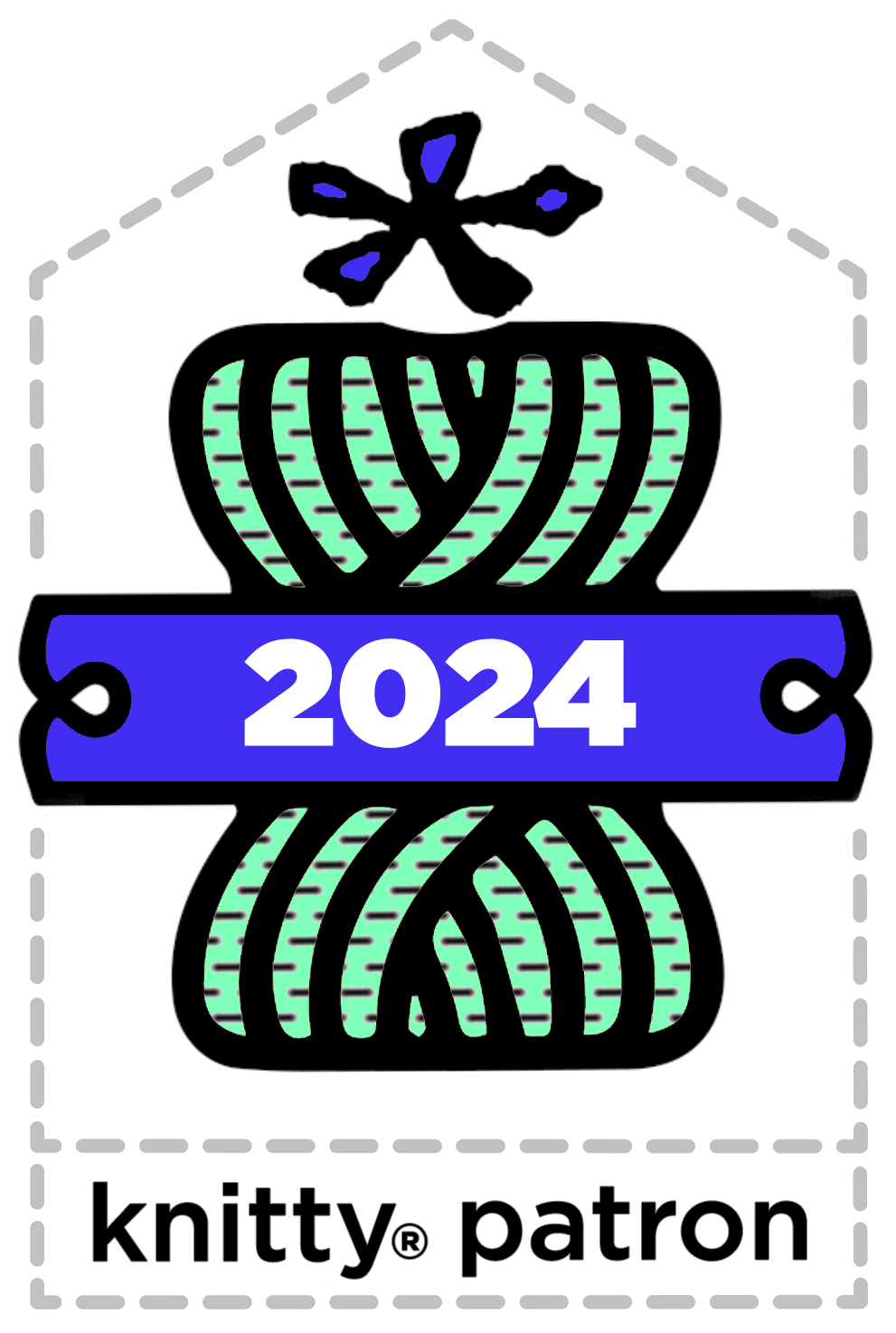Polkadrop, a free knitting pattern from Knitty.com.
INTRODUCTION
Polkadrop
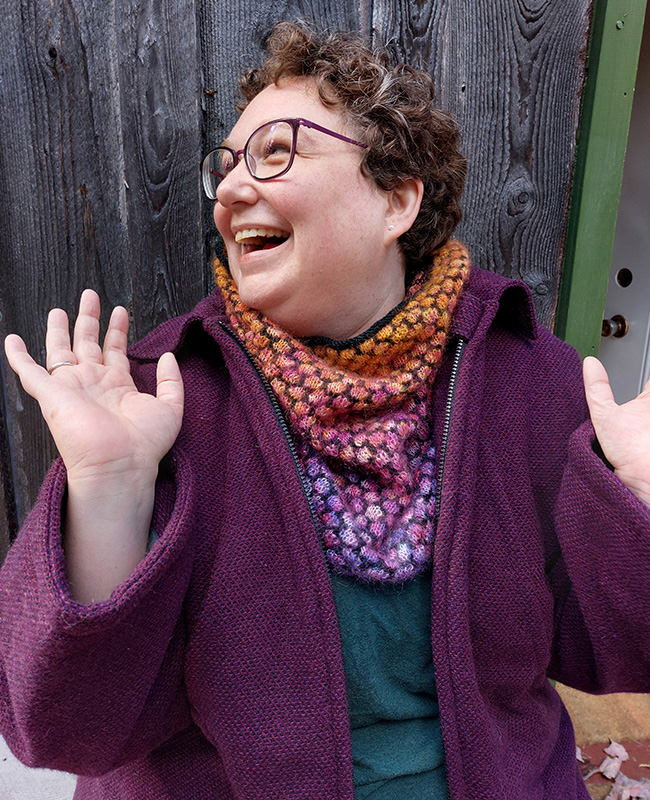 by Marit Munson
by Marit Munson
![]()
Graphic and poppy, Polkadrop uses a tuck stitch pattern to highlight the ethereal fuzz of a favorite mohair/ silk laceweight against a backdrop of fingering-weight wool. Lightweight but warm, the cowl puddles around your neck like a fuzzy companion. Should you find yourself outside in a cold snap, tuck Polkadrop firmly into the collar of your coat and let all of that fluffy glory trap the warmth around your neck. If you prefer a closer fit (or a longer double-loop size), it's easy to adjust the circumference to suit your taste; just cast on any multiple of 4 stitches and away you go.
Polkadrop is mostly a simple knit, but it does have a few quirks that make the pattern a little tangy. For one thing, you'll need to switch needle sizes frequently, using a small needle to create a firm structure of fingering-weight wool and a larger needle to give the mohair/ silk laceweight bubbles a chance to poof out into their full glory. (If life is hard enough already and you just want to knit the whole cowl on the smaller size needle, go for it. Your bubbles will be a bit less transparent, but that's not the end of the world.)
As for the knitting itself, the majority of the rounds are plain stockinette. It's every sixth round that'll test your patience, as it requires dropping down four rounds of mohair to do a tuck stitch. It's undeniable: unraveling fuzz is fussy. Still, watching the bubbles pop off your needles is so satisfying that you might well find yourself compelled to keep going, regardless of the late hour and the alarm clock awaiting you the next morning. And if you knit yours in a dappled gradient, with ever-changing colors that glow through the mohair halo? You might as well just give in and let the Polkadrop Cowl trap you in a joyous haze of color.
 model: Elizabeth Stregger
model: Elizabeth Stregger
 photos: Marit Munson
photos: Marit Munson
SIZE
One
FINISHED MEASUREMENTS
Circumference: 32 inches/ 82 cm
Height: 16.5 inches/ 40 cm
MATERIALS
Yarn
![]() [MC] gobsmacked yarn Fuzz [72% kid mohair, 28% silk; 459 yd/ 420 m per 1.8 oz/50 g skein]; color: That Everlasting Glowworm; 1 skein
[MC] gobsmacked yarn Fuzz [72% kid mohair, 28% silk; 459 yd/ 420 m per 1.8 oz/50 g skein]; color: That Everlasting Glowworm; 1 skein
(Sample shown used 46 g)
![]() [CC] gobsmacked yarn Merino fingering [100% superwash merino wool; 395 yd/ 361 m per 3.5 oz/ 100 g skein]; color: Inkadoo; 1 skein
[CC] gobsmacked yarn Merino fingering [100% superwash merino wool; 395 yd/ 361 m per 3.5 oz/ 100 g skein]; color: Inkadoo; 1 skein
(Sample shown used 60 g)
Yarn Characteristics
![]() This pattern features a MC of laceweight mohair/ silk, hand-dyed in a dappled gradient. Any skein of similar composition would work as a substitute, whether solid, semi-solid, tonal, or variegated. The CC is a two-ply superwash merino fingering-weight yarn. Any smooth fingering-weight wool dyed as a solid, semi-solid, or tonal would work well as a substitute.
This pattern features a MC of laceweight mohair/ silk, hand-dyed in a dappled gradient. Any skein of similar composition would work as a substitute, whether solid, semi-solid, tonal, or variegated. The CC is a two-ply superwash merino fingering-weight yarn. Any smooth fingering-weight wool dyed as a solid, semi-solid, or tonal would work well as a substitute.
The contrast between the weight and fuzziness of the two yarns is key to the cowl's fuzzy bubbles, so be sure that your CC is heavier and smoother than your MC.
Recommended needle size
[always use a needle size that gives you the gauge listed below - every knitter's gauge is unique]
![]() US #2.5/3mm circular needle, 20-24 inch/ 50-60 cm, for working in the round
US #2.5/3mm circular needle, 20-24 inch/ 50-60 cm, for working in the round
![]() US #4/ 3.5 mm circular needle, 20-24 inch/ 50-60 cm, for working in the round
US #4/ 3.5 mm circular needle, 20-24 inch/ 50-60 cm, for working in the round
Notions
![]() 1 stitch marker
1 stitch marker
![]() yarn needle
yarn needle
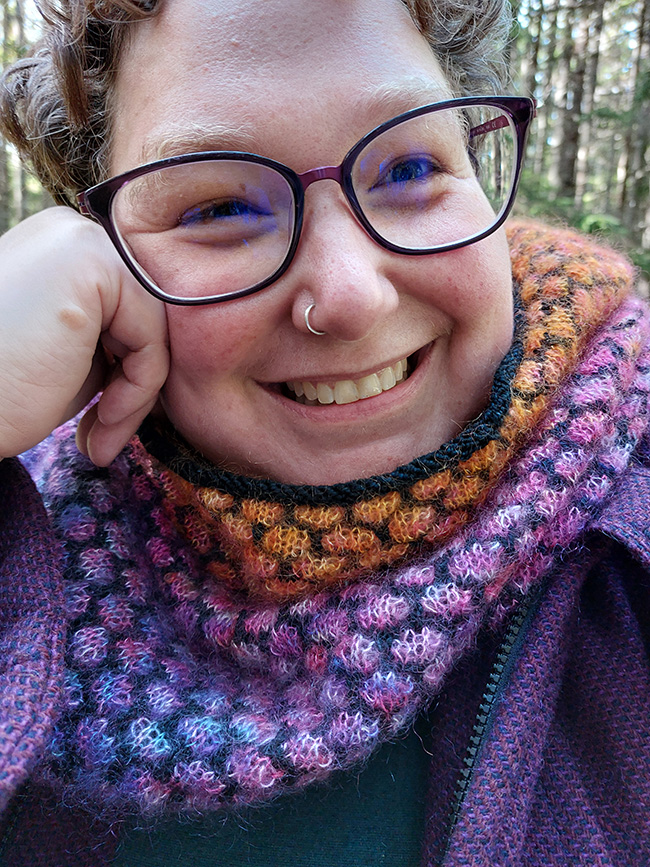
GAUGE
21 sts/32 rounds = 4 inches/10 cm in St st (on smaller needle, in CC yarn)
22 sts / 52 rounds = 4 inches/10 cm in bubble tuck stitch pattern (using both needles, with both MC and CC yarn)
Note: The combination of two different yarn weights plus the tuck stitch makes it difficult to measure gauge accurately for the pattern stitch. I recommend choosing the needle size that gives you appropriate gauge in St st with the CC yarn, then going up one or two sizes for the larger needle.
PATTERN NOTES
[Knitty's list of standard abbreviations and techniques can be found here.]
Construction method:
This cowl is worked in the round, from the bottom up, beginning and ending with a rolled St st edge. The larger needle is always used for the MC; the smaller needle is used for the CC.
Bubble tuck stitch (Bt):
Slide st off left-hand needle and drop it down 4 rounds. This leaves a live CC stitch exposed 5 rounds below the working round.
Insert right-hand needle from front to back into the exposed CC stitch. The 4 strands of unraveled MC should rest across the needle between the needle tip and the live CC stitch. Wrap the working yarn around the right-hand needle and pull it through to create a new stitch, catching the 4 loose strands of MC in the new stitch.
Notes:
The sticky nature of the mohair/ silk makes it difficult to drop the stitches. I find it helpful to use the right-hand needle to gently pick apart each stitch round by round, making sure that the stitch is completely freed before moving to the next one down.
When changing yarn between rounds, always pick up the new yarn from underneath the previous yarn.
If you wish to adjust the size of your cowl, note that 2 bubbles (8 st/12 rounds) of bubble tuck stitch adds about 1.5 inches/4 cm in width and about 1 inch/2.5 cm in height.
DIRECTIONS
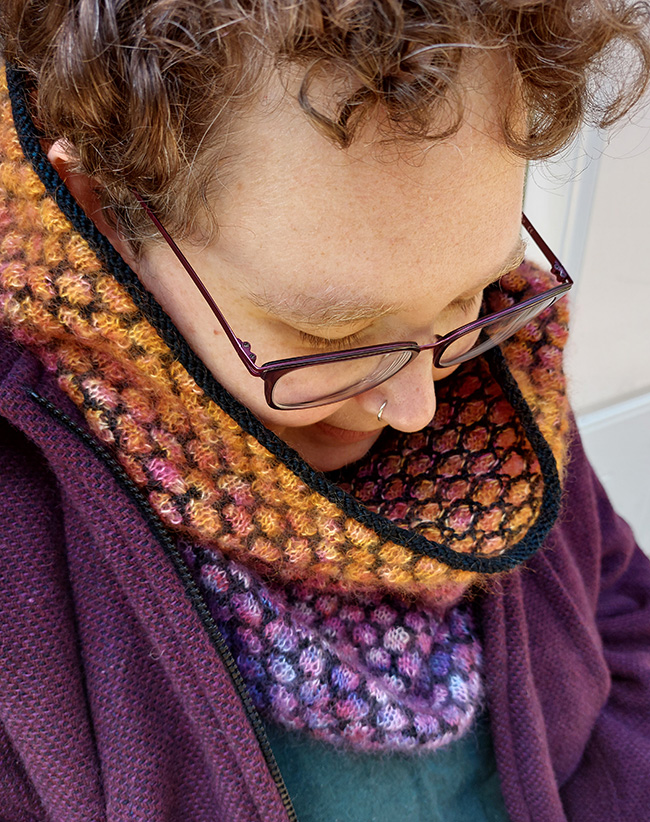
Bottom edge:
With CC and smaller needle, CO 176 st using the long-tail method. Place marker and join to work in the rnd.
Rounds 1-6: Knit.
Join MC, and keep both yarns attached throughout. You will be changing between smaller and larger needles as you work.
Body of cowl:
Rounds 1-4 [MC, larger needle]: Knit.
Round 5 [CC, smaller needle]: *K3, Bt; rep from * to end of rnd.
Round 6 [CC, smaller needle]: Knit.
Rounds 7-10 [MC, larger needle]: Knit.
Round 11 [CC, smaller needle]: K1, Bt, *k3, Bt; rep from * to last 2 sts, k2.
Round 12 [CC, smaller needle]: Knit.
Work Rnds 1-12 an additional 16 times. To modify the height of the cowl, work more or fewer round to the desired height, ending on Rnd 6 or Rnd 12.
Cut MC.
Top edge:
Change to smaller needle, larger needle will no longer be needed.
Rounds 1-6 [CC]: Knit.
BO using the larger needle.
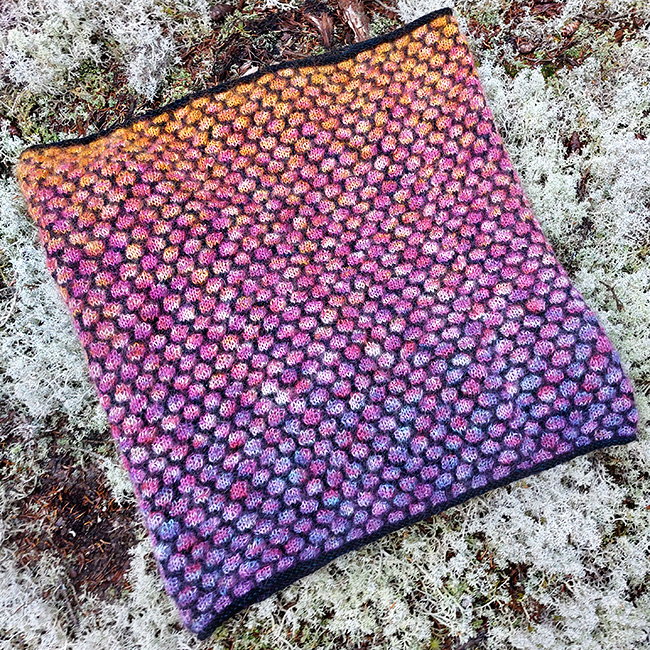
FINISHING
Weave in ends. Wet block by soaking the cowl in room-temperature water for 15-20 minutes, adding a rinse-free wool wash if you wish. Gently squeeze out excess water, then roll the cowl in a towel and press firmly to soak up additional water. Lay the cowl flat on blocking mats or a dry towel and allow to dry without pinning. You may want to lightly scrunch the fabric in order to allow the bubbles to find their natural rounded shape.
ABOUT THE DESIGNER
 Part color fiend, part hypothesis muppet, gobsmacked yarn founder Marit Munson learned to dye yarn in 2012 and immediately began asking "What would happen if...?" After a successful career as an archaeologist (yes, really), she recently moved to Canada's East Coast to join her wife on the shores of the Bay of Fundy.
Part color fiend, part hypothesis muppet, gobsmacked yarn founder Marit Munson learned to dye yarn in 2012 and immediately began asking "What would happen if...?" After a successful career as an archaeologist (yes, really), she recently moved to Canada's East Coast to join her wife on the shores of the Bay of Fundy.
Her next big adventure is opening a yarn store and dye studio in the quirky marsh town of Sackville, New Brunswick. Find her on the Web.
Pattern & images © 2023 Marit Munson







